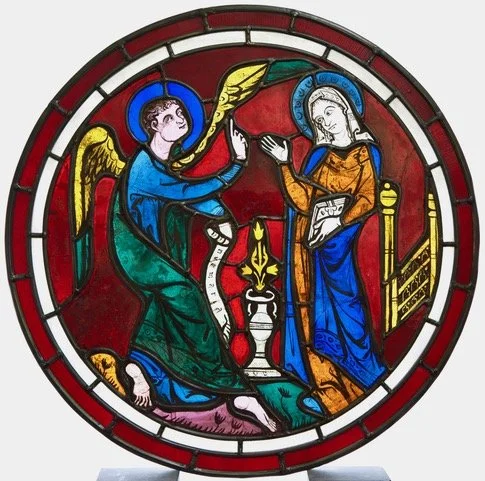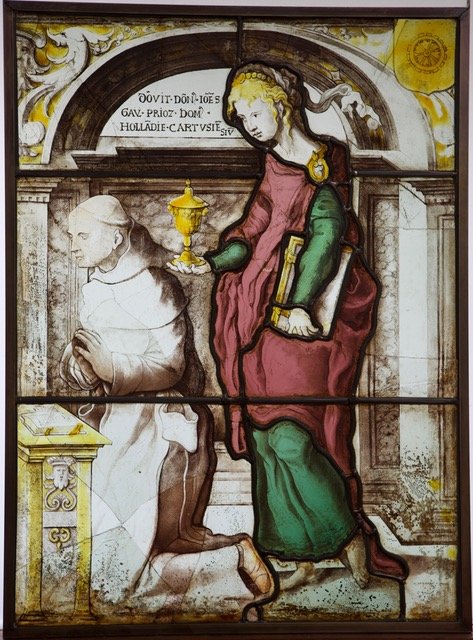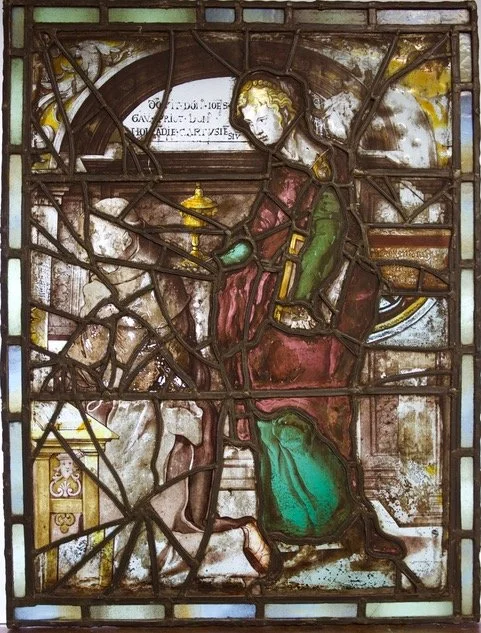

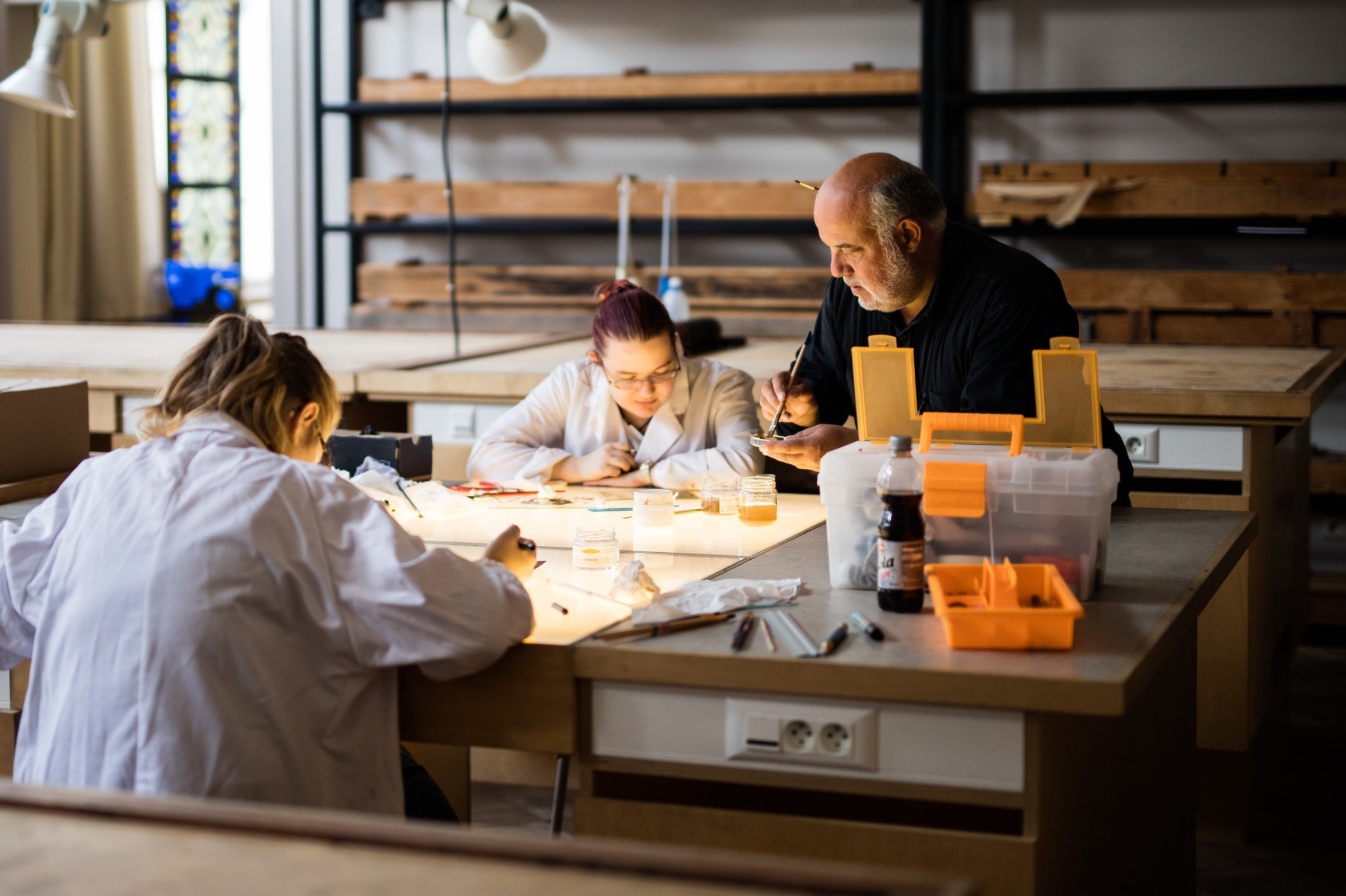

Projects
Conservation-Restoration
Projects
Conservation-Restoration
Annunciation 13thC
Collection Museum Mayer van den Bergh
before and after treatment
Triumph of Time (ca.1530)
Private Collection
before and after treatment
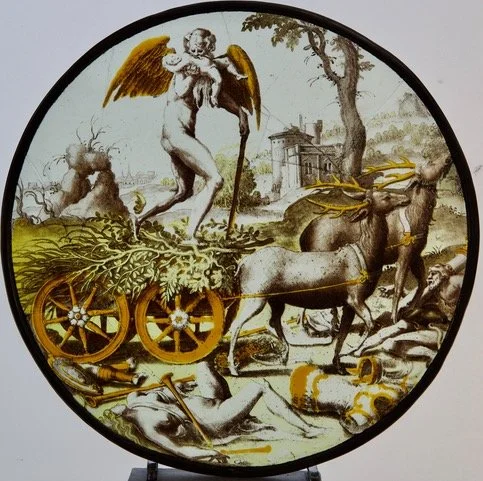
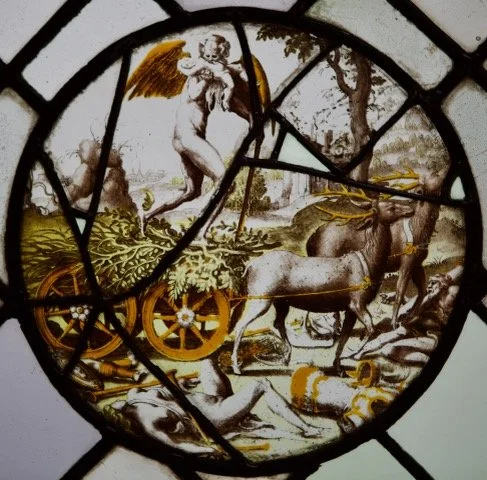
Charter House panel (ca. 1540)
Private Collection
before and after treatment
-
The conservation-restoration of stained and leaded glass has evolved from a very crafts linked activity towards a conservation science.
The activities and especially the ‘Guidelines’ (1989 and 2004) of the Corpus Vitrearum have played an important role in this change during the last decades.
Also the establishment of the stained glass conservation course at Bachelor and Master level at the University of Antwerp, has played an important role in the changing of approach as different former students have spread the new insights and techniques all over Europe.
Historic techniques and materials, as well as deterioration processes are now scientifically studied and conservation methods are defined after clear assessment of the condition of the window and its environment.
Also concerning preventive and passive conservation it is now obvious that protective glazing is actually the only possibility to preserve our stained and leaded glass from further and accelerated decay.
-
Museum Mayer van den Bergh - Antwerp, 2021
Monastery of Grauwzusters UA - Antwerp, 2019
Museum De Lakenhal - Leiden (NL), 2018
Private collection - Eppelheim (DE), 2017-2018
Private collection - Den Haag (NL), 2017-2018
Cathedral of S. Baafs - Ghent, 2017
Private collection - Brasschaat, 2017
Museum De Lakenhal - Leiden (NL), 2015
Mirror - Michel Martens, 2014
Bruggemuseum - Bruges, 2014
E. Van Steenbergen - Brasschaat, 2013
Museum of the Brotherhood of the Holy Blood - Brugge, 2013
Castle of Rumbeke - 2012
City of Tongeren - 2012
Museum Boijmans of Beuningen - Rotterdam (NL), 2012
Museum M - Leuven, 2010-2011
Rectorate University of Antwerp - 2008
Castle chapel Loppem - Loppem, 2007
Museum Jan Heestershuis - Schijndel (NL), 2006
Osterriethhuis - Antwerp, 2006
Museum Plantijn-Moretus - Antwerp, 2006
Museum Mayer van den Bergh - 2005, 2003 and 2001
S. Vincentius Hospital - Antwerp, 2005
Casino - Ostend, 2005
Gruuthusemuseum - Bruges, 2005
Abbey ‘t Park - Heverlee, 2005
Gruuthusemuseum - 2004
Private collection - Den Haag (NL), 2003
Arch. W. Vanden Broek - Deurne, 2003
Monostary of Grauwzusters - Antwerp, 2003
Abbey of Averbode - Averbode, 2002
School of S. Ludgardis - Antwerp, 2001
Senatorium chapel - Kortrijk, 2001

Studie, Advise & Articles
Studie, Advise & Articles
-
Museum of Fine Arts • Behind glass painting - Brussels, 2018
Hampden House - Great Hampden (UK), 2018
Municipality of Roermond • archaeological flat glass finds - Heerlen & Roermond (NL), 2018
O.L.V. church - Sint-Genesius-Rode, 2017
Municipality of Roermond • archaeological flat glass finds - Roermond (NL), 2016-2017
Sam Fogg • Neave collection - Londen (UK), 2016
O.L.V. cathedral - Antwerp, 2013
S. Pieters church - Wezembeek-Oppem, 2009
S. Stefanus church - Oppem, 2009
O.L.V Hemelvaart church - Liezele (Puurs), 2008
S. Blasius church - Waardamme (Oostkamp), 2008
S. Amandus church - Bekegem, 2007
S. Brixius-Rode church - 2005
O.L.V. church - Kampenhout, 2005
O.L.V. Steenbergen chapel - Heverlee, 2004
Sint-Catharina church - Hoogstraten, 2003
S. Sebastiaans church - Linkebeek, 2003
S. Ursmarus church - Oetingen, 2002
O.L.V. S. Stefanus church - Dentergem, 2002
S. Laurentius church - Hamont-Achel, 2001
O.L.V. church - Zonnebeke, 2001
-
Town Hall Lerwick - Schotland (Shetland) (GB), 2017
Museum M • SWOT advice stained glass window - Louvain, 2013
‘Postgebouw’ - Ostend, 2011
'Topstukken Vlaanderen' - 2010
Peter College - Cambridge (UK), since 2009
Regie der Gebouwen - 2004
‘Brouwershuis’ - Antwerp, 2004
Koln (DE) - Berlin (DE) - Workum (NL), since 2000
S. Jan Baptist church - Workum (NL), 2000
Cathedral Léon (Sp) - Léon (ES), since 1997
Advice - Sevilla - Girona - Dom of Altenberg - Soest,
-
J. CAEN,C. BERSERIK: ‘Fables - Stories and Other Literature Depicted in Stained-Glass Roundels and Small Panels from the Low Countries ’ in Word and Image - Corpus Vitrearum - 27th International Colloquium, York (UK), July 2014, pp. 66-72.I
M. VANDEVIJVERE - L. VAN DE VOORDE - J. CAEN - P. VAN ESPEN - B. VEKEMANS - L. VINCZE - O. SCHALM: ‘Manufacturing Techniques and Production Defects of 16th-17th Century Majolica Tiles from Antwerp (Belgium)’ in: ROEMICH - H. - VAN LOOKEREN-CAMPAGNE - K. (red.): Recent Advances in Glass - Stained-glass - and Ceramics conservation 2013 - ICOM-CC - Corpus Vitrearum-ICOMOS Amsterdam-conferentie okt. 2013 - Zwolle, 2013, pp. 169-176.
K. DE VIS - J. CAEN - K. JANSSENS - P. JACOBS: ‘The Consolidation of Cracks and Fissures in Dalle de Verre: Assessment of Selected Adhesives’ in: ROEMICH - H. - VAN LOOKEREN-CAMPAGNE - K. (red.): Recent Advances in Glass - Stained-glass - and Ceramics conservation 2013 - ICOM-CC - Corpus Vitrearum-ICOMOS Amsterdam-conferentie okt. 2013, Zwolle, 2013, pp. 43-52.
J. M. A. CAEN: ‘Een toekomst voor ons verleden. Vijfentwintig jaar Opleiding conservatie-restauratie’ - in: DE VOS - E. - LOMBAERDE - P. (red.): Van academie tot universiteit. 350 jaar architectuur in Antwerpen - Brussel, 2013, pp. 202-207.
J. CAEN - S. CAGNO - K. JANSSENS: ‘The Stained-glass Panel Depicting The Anointing at Bethany – Art Historical Research - Technical Analysis - and Treatment.’ in: ROEMICH - H. - VAN LOOKEREN-CAMPAGNE - K. (red.): Recent Advances in Glass - Stained-glass - and Ceramics conservation 2013 - ICOM-CC - Corpus Vitrearum-ICOMOS Amsterdam-conferentie okt. 2013 - Zwolle, 2013, pp. 247-257.
M. - VAN GRIEKEN - J. - VAN CALSTER - P. (red.): Getekend - Jan R. Een renaissancemeester herontdekt - tentoonstellingscatalogus - Mercatorfonds - Brussel, 2012.
PALLOT-FROSSARD - J. CAEN - L. SELIGER - C. LOISEL: 'Return to a Recent Past. The application of coatings and consolidants on stained-glass windows of the cathedrals in Le Mans (F) and Canterbury (UK) : Success or failure ?' in: Corpus Vitrearum - Forum for the Conservation of Stained Glass: 20th and 21st century stained glass - Lisbon - 26-28 September 2011 - Lisboa, 2012 (in the press)
K. DE VIS - K. BREDA - J. CAEN - K. JANSSENS - P. JACOBS: 'Innovative dalle de verre technology in Beringen (B). Evolution of collaboration between miners - artists - architects and today’s conservation treatment' in: Corpus Vitrearum - Forum for the Conservation of Stained Glass: 20th and 21st century stained glass - Lisbon - 26-28 September 2011 - Lisboa, 2012 (in the press)
O. SCHALM - K. PROOST - K. DE VIS - S. CAGNO - K. JANSSENS - F. MEES - P. JACOBS - J. CAEN: 'Manganese staining of archaeological glass: The characterization of Mn-Rich inclusions in leached layers and a hypothesis of its information' - in: Archaeometry 53 - 1, 2011, pp. 103-122.
J. CAEN: ‘Stained glass materials and techniques in the Low Countries during the Renaissance and Baroque era.’ - in: Annales du 18e congrès de l’Association Internationale pour l’Histoire du Verre - Thessaloniki, 2009 - Thessaloniki, 2011.
K. DE VIS - P. JACOBS - K. JANSSENS - J. CAEN: 'The consolidation of cracks in architectural glass and Dalle de Verre: First assessment of possible adhesives' in: Glass Science in Art and Conservation - GLASSAC 11 Conference - 10-12 Mei - Stuttgart, 2011, pp. 59-61.
C. J. BERSERIK en J. M. A. CAEN: ‘Silver-Stained Roundels and Unipartite Panels before the French Revolution. Flanders - Vol.2: The Provinces of East and West-Flanders.’ Corpus Vitrearum Checklist - Turnhout, 2011.
S. CAGNO - G. NUYTS - S. BUGANI - K. DE VIS - O. SCHALM - J. CAEN - L. HELFEN - M. COTTE - P. REISCHIG - K. JANSSENS: 'Evaluation of manganese-bodies removal in historical stained glass windows via SR-µ-XANES/XRF and SR-µ-CT' - in: JAAS - Oktober 2011 (www.rsc.org/jaas)
J. DEWANCKELE - F. ZANINI - N. SODINI - A. VICHI - J. CAEN - P. JACOBS: 'Re-treatability investigations of weathered stained glass windows by means of micro focus X-ray CT and phase contrast CT' in: Glass Science in Art and Conservation - GLASSAC 11 Conference 10-12 May - Stuttgart, 2011, pp. 71-73.
J. CAEN: 'Innovative technology in contemporary stained-glass design: photovoltaic solar cells and LED lamps in some of my recent creations' - in: Glass Science in Art and Conservation - GLASSAC 11 Conference 10-12 May - Stuttgart, 2011, pp. 23-26.
DE VIS K. - CAGNO S. - VAN MOL W. - SCHALM O. - JANSSENS K. - CAEN J.: The decolourization of manganese-stained glass: The conversion reaction and evaluation of its effectiveness in‘Annales du 18e congrès de l’association internationale pour l’histoire du verre - Thessaloniki, 2011 - p. 463-468.
J. CAEN: ‘Conservation-Restoration Education in Europe in General - and at the Antwerp University Association in Particular’ - in An approach to Cultivation of Modern Art and Design Talents, 2010 - Shanghai - p. 95-104
P. MOTTNER - U. BRINKMANN - I. PALLOT-FROSSARD - T. WARSCHEID - L. SELIGER - S. TRUEMPLER - J. CAEN - F. ZANINI - P. JACOBS - N. H. TENNENT - P. KARASZKIEWICZ: ‘The CONSTGLASS-Project: Screening of Restoration-Conservation Campaigns and Materials Development for the Sustainable Preservation of European Stained Glass Windows.’ in: The Art of Collaboration. Stained-Glass in the 21st Century - Brepols Publishers/American Corpus Vitrearum - Turnhout, 2010.
C.J. BERSERIK - J.M.A. CAEN: ‘Silver-Stained Roundels and Unipartite Panels before the French Revolution. Flanders - Vol.II: The Provinces of East and West-Flanders.’ Corpus Vitrearum Checklist - Turnhout, 2010
Deterioration of Window Glass Fragments and Paint Layers from Two Seventeenth-Century Stained Glass Windows Created by Jan de Caumont (c.1580-1659) in: Studies in Conservation 55, 2010 - p. 216 - 226.
J. CAEN - K. DE VIS - N. H. TENNENT: ‘Reversibility of Polymer Treatments on Stained Glass.’ in: The Art of Collaboration. Stained-Glass in the 21st Century - Brepols Publishers/American Corpus Vitrearum - Turnhout, 2010 (in print).
N. H. TENNENT - J. CAEN - P. COURTNEY - E. LOZANO DIZ: ‘In situ Raman spectroscopic characterisation of polymers used in past conservation treatments.’ - in: E-Preservation Science (special issue for the IRUG8 Vienna Conference) - 6, 2009 - p. 107 - 111.
N. H. TENNENT - J. CAEN - P. COURTNEY - E. LOZANO DIZ: ‘In situ Raman spectroscopic characterisation of polymers used in past conservation treatments.’ in: Application Note, 2009.
J. CAEN: The Production of Stained Glass in the County of Flanders and the Duchy of Brabant from the XVth to the XVIIIth Centuries: Materials and Techniques - Brepols - Turnhout, 2009. (Doctoraatsdissertatie)
K. JANSSENS - P. DEGRYSE - P. COSYNS - J. CAEN - L. VAN ’T DACK: Annales du 17e congrès de l’Association Internationale pour l’Histoire du Verre – Anvers, 2006.’ - Antwerp, 2009.
J. CAEN (red.): ‘Joost Caen’ - (book & DVD) - Schoten, 2009.
J. CAEN - O. SCHALM - K. JANSSENS: ‘15th century stained-glass windows in the former County of Flanders: a historical and chemical study related to recent conservation campaigns’ - in: Annales du 17e congrès de l’Association Internationale pour l’Histoire du Verre – Anvers, 2006 - Antwerp, 2009 - p. 459 - 466.
J. CAEN - C. BERSERIK: ‘Silver-Stained Roundels and Unipartite Panels in the Low Countries: Workshop practice’ - in: Die Einzelscheibe. Le vitrail en solitaire. The single stained-glass panel. (Akten des 24. Internationalen Kolloquiums des Corpus Vitrearum - Zürich 2008) - Romont, 2009 - p. 121-131.
J. CAEN en B. DE MUNCK: ‘Les métiers: entre la qualité des oeuvres et l’innovation technologique. Recettes et prescriptieons techniques pour la production de vitraux dans les Pays-Bas méridionaux du XVe au XVIIIe siècle’ - in: ‘Le vitrail et les traités du Moyen Age à nos jours’ - Actes du XXIIIe colloque international du Corpus Vitrearum - Tours 2006 - Bern, 2008 - p. 149 - 177.
J. CAEN - O. SCHALM - A. PIRES DE MATOS - A. RUIVO - M. FERREIRA en K. JANSSENS: ‘Reproduction of 16-17th Centuries Enamels for Stained Glass after Orignal Compositions and Recipes.’ in: ’GLASSAC-08 Glass Science in Art and Conservation’ - Valencia, 2008 - p. 39.
J. CAEN - B. DE MUNCK - L. LANGOUCHE: ‘Het verleden herscheppen. De restauratie-ethiek en –praktijk in het negentiende eeuwse glasatelier Bethune-Verhaegen’ - in: Trajecta - 17, 2008 - p. 145 - 162.
J. CAEN: ‘De Opleiding Conservatie/Restauratie aan de Hogeschool Antwerpen’ - in: ICOMOS Contact - 2 - Brussels, 2007.
J. CAEN - L. LANGOUCHE - B. DE MUNCK: ‘Conservation Ethics in the 19th Century Stained-Glass Firm of Bethune-Verhaegen.’ - in: Techniques du vitrail au XIXe siecle - Les dossiers de l’IPW - 3 - Namur, 2007 - p. 23 - 34.
C.J. BERSERIK en J.M.A. CAEN: ‘Silver-Stained Roundels and Unipartite Panels before the French Revolution. Flanders - Vol.I: The Province of Antwerp’ - Corpus Vitrearum Checklist - Turnhout, 2007.
J. CAEN: ‘Acquisition of Capronnier Archives by the Flemish Goverment’ - in: Newsletter of the ICOM Committee for conservation - Working Group “Glass and Ceramics” - Issue 15 - Winter 2006-2007 - p. 11.
G. VAN DER SNICKT - O. SCHALM - J. CAEN - K. JANSSENS - M. SCHREINER: ‘Blue Enamel on Sixteenth- and Seventeenth-Century Window Glass-Deterioration - microstructure - composition and preparation.’ in: ‘Studies in Conservation’ 51, 2006 - p. 212 - 222.
M. GARCIA-HERAS - M.A.VILLEGAS - J.M.A. CAEN - C. DOMINGO - J.V. GARCIA-RAMOS: ‘Patination of historical stained windows lead cames from different European locations.’ in: ‘Microchemical Journal’ 83, 2006 - p. 81- 90.
J. CAEN - B. DE MUNCK: ‘Technical Prescriptions for Production of Stained and Leaded Glass in Guilds’ Ordinances and Recipe Books in the Southern Netherlands in the 15th - 16th - 17th and 18th Centuries.’ - in: ‘Le Vitrail et les traités du Moyen Age à nos jours’ - Corpus Vitrearum - Tours, 2006 - p. 24 - 25.
J. CAEN: ‘Glass painting techniques in The Netherlands in the sixteenth century’ - in: W. DE GROOT et al.: The Seventh Window - Hilversum, 2005 - p. 243 - 250.
J. CAEN: ‘Kunst en geloofscommunicatie’ - in: P. Kevers - J. Maex (red.) - Toekomst voor verhalen en rituelen? Louvain, 2005 - p. 169 -174.
J. CAEN: ‘The conservation of two seventeenth-century enamelled stained glass windows by Jan de Caumont in the Abbey ‘t Park in Leuven - Belgium (Flanders)’ - in: Annales du 16e congrès de l’Association Internationale pour l’Histoire du Verre (AIHV) - (London 2003) - Nottingham, 2005 - p. 364 - 366.
J. CAEN - O. SCHALM - G. VAN DER SNICKT - S. LUYTEN,V. VAN DER LINDEN - P. FREDERICKX - D. SCHRYVERS - K. JANSSENS - E. CORNELIS - D. VAN DYCK - M. SCHREINER: ‘Enamels in stained-glass windows: preparation - chemical composition - microstructure and causes of deterioration’ - in: Glass Science in Art and Conservation - GLASSAC - Lisbon, 2005 - p. 121-126.
J. CAEN: ’Met glas geschreven’ - exhibition brochure - ‘t Kristallijn - Mol, 2004.
O. SCHALM,K. JANSSENS - J. CAEN: ‘Characterization of the main causes of deterioration of grisaille paint layers in 19th century stained-glass windows by J.-B. Capronnier ‘ - in: Spectrochimica Acta - Part B, 2003 - p. 589 - 607.
K. DE VIS - D. LEMBRIH-SIMBÜRGER - O. SCHALM - M. SCHREINER - J. CAEN:‘The colour of silver stained glass - analytical Investigations carried out with XRF - SEM/EDX - TEM - and IBA’ - in: Journal of analytical absorption Spectrometry (JAAS) - Vol. 17/4 , 2002 - p. 321 - 328.
J. CAEN - S. CAGNO - K. JANSSENS: 'De conservatie-restauratiebehandeling van het 16de eeuws gebrandschilderd paneel met de voorstelling van Jezus in het huis van Simon de Melaatse. Museum M Leuven – Inv. nr.: B/III/259' in: BRUIJEN - Y. - CAEN - J. - DEBAENE,
J. CAEN - B. DE MUNCK - V. DE LAET: ‘Technical Prescriptions and regulations for Craftsmen in the Southern Netherlands during the Sixteenth - Seventeenth and Eighteenth Centuries. A Confrontation of Archival and Material-Technical Information regarding Glazing and Stained-Glass Windows.’ - colloquium ‘Verre et Fenêtre’ in Paris (on-line publication).
O. SCHALM - J. CAEN - K. JANSSENS: ‘Homogeneity - Composition and

Teaching
Teaching
Conservation-Restoration Education in Europe in General, and at the Antwerp University in Particular.
EM. Prof. Dr. Joost Caen, FIIC
-
Until now conservation-restoration education at academic level is mainly situated in Europe. The dynamism in the Far East is at present also resulting in a very strong and interesting development in the field of cultural heritage.
In many countries this is also a way to reflect on the own history and the local identity in relation to a globalising world. Building museums, protecting historical monuments and sites, establishing archives and libraries, etc. involves, among other, the contribution of well-educated conservator-restorers.
With this lecture I want to present the recent evolution in the field of conservation-restoration education in Europe and explain the present ‘state of the art’ at our school for conservation in Antwerp.
-
Conservation-Restoration education in Europe [1] evolved significantly since the Second World War. Some decades ago ‘restoration’ of cultural heritage was in many cases a crafts based activity and training was merely a matter of co-operation during these activities. In many countries it became clear that the level of these interventions was very often quite low, as the knowledge of materials and techniques got lost more and more. Moreover there was often neither any ethical background nor basic scientific research.
Later it became also increasingly evident that the conservation of cultural heritage poses problems too complex to be solved within the then existing systems of practise, based on craft skills supported by related academic disciplines e.g. art history, science, etc. Therefore in many European countries new programs were established at universities or at schools with similar academic levels.
During this time many academic study programmes in conservation-restoration of cultural heritage became established in Europe and graduates from these institutions began to enter the field of conservation-restoration. Although different in level and quality of provision, all these study programmes aimed to draw together the necessary practical and technical skills with those of related humanistic and scientific disciplines. They were designed to provide structured programmes of study, where practice was supported by a clear underpinning of knowledge, and where research could be supported and fostered. The science of conservation-restoration became established, which is the basis of practical skills (both preventive and interventive) necessary for the conservation of cultural heritage.
The dangers of commercial interests and pressures, which could result in poor quality conservation-restoration with potentially disastrous and irreversible results, were also acknowledged. The Document of Pavia recommended “the establishment of a regulatory framework to guarantee the quality of intervention on cultural heritage or its environment in order to avoid the negative impacts of market forces…” [2] e.g. in Greece, a law was passed on education and practice in conservation/restoration[3] and an Act of Protection of the professional title “Restorer” was passed by the Parliament of Mecklenburg Vorpommern, Germany, to ensure necessary quality in the protection of cultural heritage.[4]
Although conservation-restoration is now well established as a subject area within universities and other academic institutions in many European countries (Austria, Belgium, Croatia, Denmark, Finland, France, Germany, Greece, Hungary, Norway, Poland, Portugal, Spain, Sweden, Switzerland, The Czech Republic, The Netherlands, United Kingdom) in others it is less well established although some courses offered may have the same ‘level’ of provision as a university. In the last ten years, there has been a clear move towards a more common agreed level and structure to courses supported by the Bologna agreement to implement a common European higher education system.[5]
More than ever, cultural heritage has become a matter of global importance and interest. The study and conservation, or the lack of study and conservation, of this heritage has become an issue with political and ideological implications. This reality urges us to act more carefully towards our cultural heritage. UNESCO defines cultural heritage as the entire corpus of material signs either artistic or symbolic, handed on by the past to each culture and so to the whole of mankind. Cultural heritage is not only a source for business and economy, but a fundamental condition for the maintenance and development of society and its economy. The preservation and presentation of cultural heritage should therefore be a corner-stone of any cultural policy. This policy can not longer depend on separate actions from individuals. Also the historic gap between theoretical and practical people has to become closed. Therefore it is of the highest importance that we educate specialists of the highest level who are able to work together with specialists in related fields and to bring together the three most important parameters to conserve cultural heritage. These parameters are: ‘knowledge’ gained by research; ‘skill’ gained by exercise and above all the correct ‘attitude’ gained by developing carefulness, critical sense and maturity.
Since governments decided to start conservation studies at academic level in order to educate conservator-restorers with a good knowledge of historical materials and techniques; modern conservation materials and techniques; human sciences; natural sciences; ethics and of course also manual interventions, the main goal is to conserve the object ànd its history as a “unity”, this in opposition to treatments in the past where too often only aesthetic or commercial parameters were dominant. Furthermore the conservator-restorer became a full partner in the family of specialists (art historians, archivists, architects, conservation scientists, …) who is presenting objects of cultural heritage to the public in a comprehensive way. Especially his or her knowledge of the materials and techniques can contribute now to the better understanding of the object; the designer of craftsman behind it, and the initial (and sometimes also later) cultural context. Since these programs started we notice a growing consensus about the content and the required quality of the courses as well as about the necessary competences to run a ‘Conservation School’.
At the meeting in Vienna (1998) held between 43 representatives of European educational institutions, research institutions and organisations within conservation-restoration, the need for clarification of university level and recognised equivalent in conservation-restoration education was expressed (FULCO project).[6] In the document of this meeting it is stated that this task should be co-ordinated by ENCoRE[7], in association with the CON.B.E.FOR. project. This has now been achieved in the form of the document “Clarification of Conservation-Restoration Education at University level or recognised equivalent” carried unanimously at the third General Assembly of ENCoRE in Munic, June 2001.[8] This document is the contribution of ENCoRE to this clarification taking into consideration the Bologna Declaration on the European Higher Education Area, and it states that the necessary existence, access, and protection of cultural heritage as a right to all humankind make great demands on the quality as well as democratic control of and public insight into all aspects of cultural heritage activities and management including education. The quality, democratic control of and public insight into conservation-restoration education can only be guaranteed by governmentally validated academic education at university level leading to protected and internationally recognised academic titles. Moreover, the clarification document defines that educational institutions, which are not called universities but which offer programmes of study which in length, content and quality are regarded by the respective governmental validating bodies (such as Ministries of Education) to be equivalent and/or compatible to university degree provision should be recognised as being the same level.
In the ENCoRE-clarification document, the discipline of conservation/restoration is defined as an empirical science, devoted to the prevention and treatment of the decay of objects of cultural heritage. It is characterised by being a mixture of theoretical knowledge and practical skills, and includes the ability to judge in a systematic way on ethical and aesthetic issues. It has its origins in arts and craftsmanship as well as in the humanistic, technical and natural sciences. Cognitive and systematic analysis, diagnosis and solution of problems as the basis for practical conservation and restoration skills is what differentiates the conservator-restorer from the artist and the craftsman. The strong basis in practical skills and knowledge of the complexity and interactivity of object material behaviour and information including environmental influences is what differentiates the conservator-restorer from professionals in other related academic fields. These definitions form the basis of, and characterise education and research in the field of conservation-restoration.
-
I.C.O.M. The Conservator-Restorer. A Definition of the Profession. Copenhagen, September 1984.
E.C.C.O. Professional Guidelines (II). Code of Ethics. Brussels, 11 June 1993.
I.C.O.M.O.S. Guidelines on Education and Training in the Conservation of Monuments, Ensembles and Sites. Colombo, 30 July – 7 August 1993.
E.C.C.O. Professional Guidelines (III). Basic Requirements for Education in Conservation/Restoration. September 1994.
Document of Pavia. Preservation of Cultural Heritage: Towards a European profile of the conservator/restorer. European summit. Pavia, 18-22 October 1997.
The ENCoRE Document of Constitution. Dresden, 1997.
-
[1] Parts of this text are based on the following article: R. LARSEN, A. BACON, J. CAEN: ‘The European Network for Conservation/Restoration Education; promotor of research and education in the field of cultural heritage’ in Cultural Heritage Research: a Pan-european Challenge, Cracow, 2002, p.169 -172.
[2] Banik, G.: Dentist, Cook and Washerwoman. Models for Training Co-operative Skills in Conservation Science and Practical Restoration. Conservation-Restoration. 25 Years School of Conservation. May 1998. Konservatorskolen, Det Kongelige Danske Kunstakademi 1998. ISBN 87-89730-25-9. p. 29.
[3] Schiessl, U.: A Law for the Protection of the Professional Title “Restorer”. ENCoRE Newsletter 4/2000, p. 17.
[4] The Bologna Declaration. The European higher education area. Joint declaration of the European Ministers of Education. Bologna 19 June 1999. (Published in ENCoRE Newsletter 4/2000, p. 23.).
[5] Conservators-Restorers of Cultural Heritage in Europe: Education Centers and Institutes. A Comparative Research. CON.BE.FOR. Associazione Giovanni Secco Suardo, Lurano (BG), Italy, 2000, ISBN 88-8420-001-6
[6] The Document of Vienna. European Conference “A framework of competence of conservators-restorers in Europe”, 30 November-1 December 1998.
[7] European Network for Conservarion-Restoration Education.
[8] Clarification of Conservation/Restoration Education at University Level or Recognised Equivalent. ENCoRE, Munic, June 2001.

